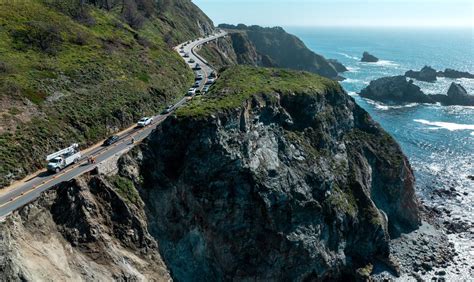The devastating collapse of Highway 1, a pivotal transportation artery along the California coast, sent shockwaves throughout the region and beyond. On January 28, 2021, the highway succumbed to the relentless forces of nature, specifically the aftermath of a significant storm that battered the area. The destruction not only severed a critical route for commuters and tourists alike but also underscored the vulnerability of infrastructure to extreme weather events. As the investigation into the cause unfolded, several key factors emerged that contributed to this collapse.
Meteorological Conditions Preceding the Collapse
The storm system that preceded the collapse of Highway 1 was characterized by intense rainfall, leading to significant runoff and swelling of nearby water bodies. The region experienced a prolonged period of wet weather, with certain areas receiving rainfall totals that were substantially above the average. This excessive moisture had a profound impact on the geological stability of the terrain surrounding the highway.
Geological Instability and Landslides
Highway 1 is constructed along a geologically sensitive area, where the combination of steep slopes, weak rock formations, and intense weather patterns creates an environment prone to landslides. The heavy rainfall saturated the ground, reducing the friction between soil particles and the underlying rock, thus increasing the likelihood of a landslide. In the case of the Highway 1 collapse, the waterlogged soil and rocks gave way, causing a massive slide that took a significant portion of the highway with it.
Infrastructure Vulnerabilities
While the primary cause of the collapse was the external force of the landslide triggered by heavy rainfall, the inherent vulnerabilities of the highway’s design and construction also played a critical role. Infrastructure built in areas known for geological instability requires special design considerations, including resilience against landslides and floods. Any shortcomings in the original design, construction materials, or maintenance could exacerbate the impact of natural disasters.
Repair Efforts and Updates
The aftermath of the collapse saw a concerted effort from state and local authorities to assess the damage and initiate repair works. Given the complexity of the situation and the need to ensure the safety and durability of any repairs, the process has been meticulous and time-consuming. Key aspects of the repair strategy include:
Geological Stabilization: Before rebuilding the highway, it was essential to stabilize the surrounding terrain to prevent future landslides. This involved various geological interventions, including the removal of unstable rock and soil, and the installation of supportive structures to secure the slope.
Highway Reconstruction: The actual rebuilding of the highway required careful planning to not only restore the original functionality but also to implement design improvements that would enhance resilience against future extreme weather events. This included the use of advanced materials and construction techniques designed to better withstand geological instability.
Environmental Considerations: Any construction or repair work in sensitive ecological areas must be carried out with minimal environmental impact. This included measures to protect local wildlife, prevent pollution, and preserve the natural beauty of the area.
Community Engagement and Support: Recognizing the significant impact of the highway’s closure on local communities and businesses, authorities have worked to maintain open lines of communication. Regular updates on the repair progress, along with initiatives to support affected businesses, have been crucial in mitigating the economic and social repercussions of the collapse.
Future-Proofing Infrastructure
The collapse of Highway 1 serves as a stark reminder of the challenges posed by climate change to infrastructure worldwide. Rising temperatures are leading to more frequent and intense weather events, placing unprecedented stress on roads, bridges, and other critical structures. The incident underscores the need for a proactive approach to infrastructure development and maintenance, incorporating resilience and adaptability as core design principles.
This necessitates a multi-faceted strategy that includes:
Advanced Materials and Technologies: Leveraging innovative materials and construction technologies that offer enhanced durability and resistance to extreme weather conditions.
Climate-Resilient Design: Ensuring that new infrastructure projects are designed with climate resilience in mind, taking into account projected changes in weather patterns and sea levels.
Regular Maintenance and Inspection: Implementing rigorous maintenance schedules and employing advanced monitoring technologies to identify and address potential vulnerabilities before they become critical issues.
Community and Stakeholder Engagement: Encouraging open dialogue with local communities and stakeholders to understand their needs, incorporate their insights, and build support for infrastructure projects.
Conclusion
The collapse of Highway 1 and the subsequent repair efforts highlight the complex interplay between natural forces, infrastructure resilience, and human activity. As we move forward in an era marked by climate change and increasing environmental challenges, the lessons learned from this event will be invaluable in guiding our approach to infrastructure development. By prioritizing resilience, employing cutting-edge technologies, and fostering community engagement, we can build a safer, more sustainable future for our transportation networks and the communities they serve.
What were the primary causes of the Highway 1 collapse?
+The primary causes of the Highway 1 collapse were the intense rainfall leading to a landslide, geological instability of the area, and the inherent vulnerabilities of the highway’s design and construction.
How are authorities addressing the repair of Highway 1?
+Authorities are addressing the repair through geological stabilization, highway reconstruction with resilient design, environmental considerations, and community engagement. The process is meticulous to ensure safety and durability.
What measures can be taken to future-proof infrastructure against similar collapses?
+Measures include using advanced materials and technologies, incorporating climate-resilient design, regular maintenance and inspection, and fostering community and stakeholder engagement. These strategies can enhance infrastructure resilience against extreme weather events and climate change impacts.


